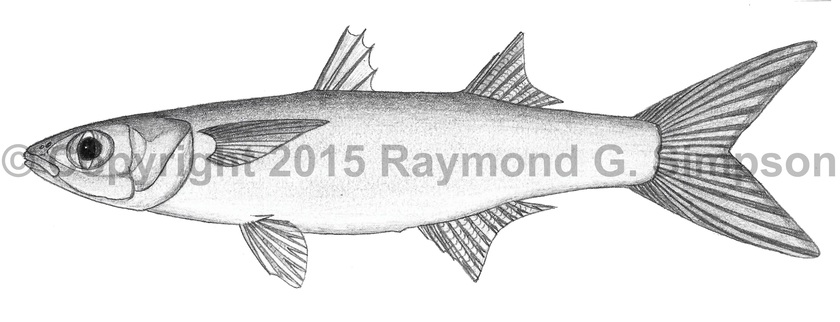
Common Name
Shortnose Mullet
Year Described
Ribeiro, 1915
Identification
Dorsal Fin: IV, 9
Anal Fin: III, 9
Pectoral Fin: II, 12-14 (13)
Lateral Scale Rows: 33-39
Transverse Scales: 12-14
Circumpeduncular Scales: 18-19
Gill Rakers: 21-75 (lower limb of first arch)
Body elongate; cylindrical anteriorly and becoming more compressed posteriorly. Snout narrowly blunt. Top of head flat. Eye diameter slightly greater than snout length. Subterminal mouth reaches anterior margin of orbit. Teeth with slightly curved tips. Adipose eyelid present (absent in juveniles). Spiny dorsal fin situated at mid-point of body. Anal fin inserted slightly forward of second dorsal fin. Dorsal and anal fins densely covered with small scales. Pectoral fin high on side and reaching well beyond dorsal fin origin. Tail forked. Body scales with tiny spines.
Color
Body pale whitish grading to dark on the dorsum. Stripes not apparent. Spiny dorsal, pelvic, and anal fin pale with few melanophores. Soft dorsal, caudal, and pectoral fin with more dense speckling. A small blotch on the pectoral base.
Size
Maximum size to 24cm SL
Habitat
Found inshore and in estuarine waters.
Range
Known for sure from the Amazonian region of Brazil to extreme SE Brazil. Records between Belize and N. Brazil are likely undescribed (see notes).
References
Durand, J.D., K.N. Shen, W.J. Chen, B.W. Jamandre, H. Blel, K. Diop, M. Nirchio, J.J. Garcia de Léon, A.K. Whitfield, C.W. Chang & P. Borsa. 2012. Systematics of the grey mullets (Teleostei: Mugiliformes: Mugilidae): Molecular phylogenentic evidence challenges two centuries of morphology-based taxonomy. Molecular Phylogenetics and Evolution, 64, 73–92.
Fraga E., H. Schneider, M. Nirchio, E. Santa-Brigida, L.F. Rodrigues-Filho & I. Sampaio. 2007. Molecular phylogenetic analyses of mullets (Mugilidae, Mugiliformes) based on two mitochondrial genes. J. Appl. Ichthyol. 23: 598-604.
Harrison I.J., M. Nirchio, C. Oliveiras, E. Ron & J. Gaviria. 2007. A new species of mullet (Teleostei: Mugilidae) from Venezuela, with a discussion on the taxonomy of Mugil gaimardianus. J. Fish Biol. 71: 76-97.
Ibáñez A.L., M. González-Castro & E. Pacheco-Almanzar. 2011. First record of Mugil hospes in the Gulf of Mexico and its identification from Mugil curema using ctenii. J. Fish Biol. 78: 386-390.
Menezes, N.A., M. Nirchio, C. Oliveira & R. Siccharamirez. 2015. Taxonomic review of the species of Mugil (Teleostei: Perciformes: Mugilidae) from the Atlantic South Caribbean and South America, with integration of morphological, cytogenetic and molecular data. Zootaxa 3918 (1): 1-38.
Nirchio, M., Paim, F. G., Milana, V., Rossi, A. R., & C. Oliveira. 2018. Identification of a new mullet species complex based on an integrative molecular and cytogenetic investigation of Mugil hospes (Mugilidae : Mugiliformes. ). Frontiers in Genetics, 9, 1–9.
Other Notes
According to Menezes et al. (2015), all records of Mugil hospes from the coast of South America are actually a separate species, M. brevirostris. Mugil hospes was described from the Eastern Pacific and is noted in having morphological differences from Atlantic material (43-45 lateral line scales vs. 33-39). Another study on “Mugil hospes” from the southwestern Gulf of Mexico (Ibáñez et al., 2011) matches the meristic range for M. brevirostris, and lateral scale rows numbered 37-39 for three specimens. Finally, a study by Nirchio et al. (2018) concluded based on molecular data that there are three lineages identified with hospes complex mullets in the New World. One is eastern Pacific, another is Brazilian, and a third corresponds to the Belize-Venezuela population (Mugil sp.R). It is likely that this third population is undescribed and sister to the Brazilian M. brevirostris.